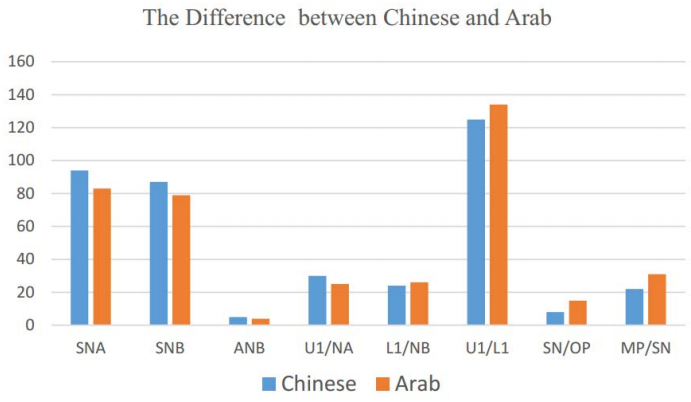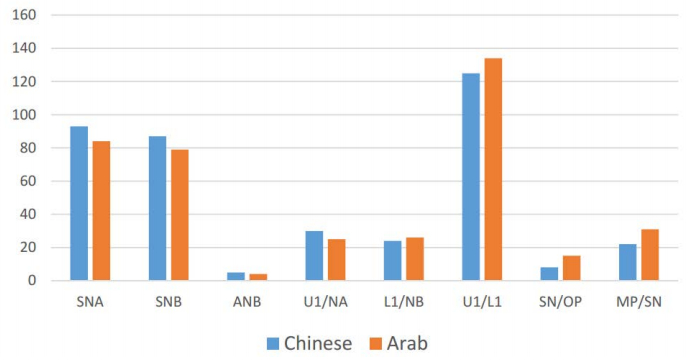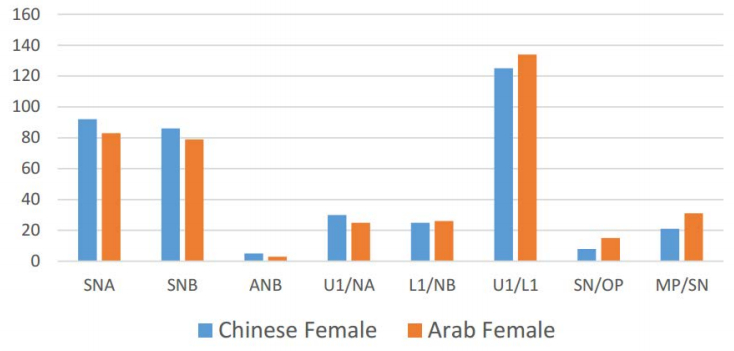1. Introduction
Food and shelter were considered before the basic necessities of life but with increasing communication, paying attention to appearances and the desire to achieve ideal proportional face, focusing on the face and the jaws increased substantially. As a result, physical anthropology had emerged to enjoy these privileges of art, beauty as Ricketts stated. The applications of cephalometric studies were introduced in classical anthropometry which is dealt with human growth and development, since then numerous types of cephalometric analysis had been created to reach these ideal beauty measurements and to evaluate craniofacial variations.
The method of standard radiograph for head and neck region was discovered eighty years ago which turned out to be a major advance in the medical field especially to the science related to the growth of the face and the jaw. In 1931 Broadbent and Hofrath [1] in Germany and USA published the first method of how obtaining standardized cephalometric head films. But Down was the one who established the first cephalometric analysis in the USA in 1984 providing a practical cephalometric analysis for diagnostic purposes.
In 1950 Steiner used SN plane as a reference line to develop numerical analysis, containing some measurements to diagnose the problem as well as provide guidance to form an accurate treatment plan by predicting the changes that result from growth or orthodontic therapy [2,3]. Steiner's analysis based on the predetermination of the sagittal position of maxillary and mandibular teeth by estimating the changes in the SNA, SNB angles, ANB angle and the position of the bony chin (Pg) to the line NB. The Estimated changes will be established at the end of the treatment [3,4].
Steiner's analysis has been used widely by orthodontists and maxillofacial surgeons, the measurements proposed for thsis analysis were collected from white Caucasians American sample or North Americans who descend from English, Polish, Dutch, French, Scottish, Spanish, and Scandinavian populations. If we view the face respectively there is a tremendous amount of facial variable measurements, differences in facial profile and skeletal features between different racial groups.Therefore, we can only use the established data for Caucasians as a reference and it is not applicable for all ethnic group [5].
The differences in Cephalometric norms and measurements in different ethnic and racial groups have been presented in many studies [6,7,8]. These studies have focused on ethnic differences, including Japanese [9], Jordanian [10], Saudi [11] and Turkish [12].
Many others studies and researches tried to find a correlation between the different measurements of anatomical landmarks, facial and malocclusion features like in Granada and Spain population [13], Chinese population [14], Caucasian [15], Arab [16,17,18,19,20]. However few studies tried to find the cephalometric norms for Middle-Eastern and Arab populations and looked for correlation with other ethnic group, specifically Chinese. Like in Rani and Faituri [34] compering Libyans norms with five different ethnic groups, and in Lahlou et al. [35] study when compared Moroccans with other populations showing Moroccans with more biprotrusion, however, the short come of these results it is only examined single nationality.
Each ethnic group must have proposed norms that reflect the acceptable ranges of measurements collected from a sample with a specific age, gender and ideal occlusion. All of which to avoid bias due to the differences in skeletal and dentoalveolar morphology and use these norms for clinical diagnosis, orthodontic treatment plane, maxillofacial surgery and prosthodontics and as standard measurements.
Therefore, the present study focused on an ethnic group for which little cephalometric information was available, the Arabs.
The purpose of this study was to formulate Cephalometric norms for Arabs, use it as a reference and compare these data with the norms of a chinses group.
2. Materials and Methods
The Arab sample group comprised 71 subjects (34 females and 37 males), natural born ethnic Arabic (Palestinian, Egyptian, Syrian, Emirate) grandparents, obtained from Ajman University of Science and Technology and Dubai Hospital with permission from Dubai health authority DHA. The Chinese sample group comprised 76 subjects (42 males and 34 females) with Chines grandparents obtained from patient's records of Orthodontic department at Union Hospital, affiliated Tongji Medical College, Huazhong University of Science and Technology, Wuhan, R.P china. This study adhered to the tents of the declaration of Helsinki. Informed consent was obtained from the patients who participated in the study.
For this Cross-sectional study all Subjects in both groups selected according to following criteria: (1) All Patients were between 20 to 29 years old; (2) Class Ⅰ molar relationship; (3) All of permanent teeth fully erupted in both jaws regardless of the third molars; (4) Well aligned maxilla and mandible with normal growth and development; (5) Good harmonious symmetrical face with balanced facial profiles; (6) No history of trauma or TMJ disorder; and (7) No history of any types of orthodontic treatment, surgical treatment, prosthetic treatment or plastic surgery.
Digital lateral cephalometric radiograph were made for each patient with the ear rods placed on both ears with the head in natural position and the teeth in centric occlusion. The x-ray source is directed to the patient's mid-sagittal plane and produces a lateral 2D image.
Cephalometric analysis software program had been used to trace and digitize (10). Anatomic landmarks (8 angular, 2 liner) according to Steiner's analysis as shown in Table 1.
Table 1. Cephalometric measurements and descriptions used in the present study according to Steiner analysis.
| SNA (82°) |
Angle formed by the intersection of S.N place and a line joining nasion and point A. this angle refer to the anterior posterior position of the maxilla in relation to the anterior cranial base. |
| SNB (80°) |
It is the angle formed between the SN plane and a line joining nasion to point B. Refer to anterior posterior position of the mandible in relation to the Cranial base. |
| ANB (2°) |
Angle is formed by the intersection of lines joining nasion to point A and nasion to point B. It denotes the relative position of the maxilla and mandible each other on skeletal bases |
| U1/L1 (130°) |
Maxillary central incisor to mandibular central incisor (U1/L1) (interincisal angle): angle is measured between the extension of the maxillary and mandibular incisor long axis line; the most posterior angle is measured It is the angle formed between the long axis of the upper and lower incisors. |
| U1/NA (22°) |
Maxillary incisor–NA angle: angle formed by the long axis of the upper incisor to a line from N to point A, A for dental assessment of the upper incisor if proclained or retroclined |
| U1-NA (4°) |
Maxillary incisor to NA plane: distance between the tip of the upper incisor and a line from N to point |
| L1/NA (25°) |
Mandibular incisor–NB angle: angle formed by the long axis of the mandibular incisor to a line from N to Point B, for dental assessment of lower incisor if proclined or retroclined |
| L1-NA (4) |
Mandibular incisor to NB (L1–NB): distance between the tip of the mandibular incisor and a line from nasion to point B |
| SN/OP (14°) |
Inclination of occlusal plane to anterior cranial base |
| MP/SN (32°) |
Angle between the SN plane and the mandibular plane (MP) |
To locate the errors related to the radiographic measurements, 25 radiographs were selected and traced again using the same cephalometric software and Dahlberg's formula two weeks following the first measurement. It was found that the difference between the first and the second measurements was insignificant. The error of the method did not exceed 0.3 mm range (0.1–0.3) for the linear measurements and for angular measurements less than 0.5 (0.1–0.5).
Independent T test analysis for the cephalometric measurements including the mean value, standard deviation, median, maximum, and minimum value each variable was calculated and compared between the two sample groups, the measurements were also compared between males and females in same group and with other ethnic groups.
3. Results
The level of significance in the current study is at p < 0.05, p < 0.001 considered as highly significant. The statistical analysis of all lateral cephalometric radiographs for two linear measurements and eight angular measurements for the entire sample (147 subjects) from both genders of Chinese and Arab samples presented in Table 1. For each variable, mean, standard deviation (SD), median, maximum and minimum were obtained.
The p values for all of the eight angular measurements comparisons were statistically significant which were less than 0.05 (p < 0.001 highly significant).On the other hand, the two linear measurements (U1-NA and L1-NB) were more than 0.05 indicating that there is no significant difference between the two groups. The means, standard deviation, median, and maximum values for SNA, SNB, ANB, and U1/NA are higher among the Chinese group compared to the other group. On the contrary the remaining angular values; L1/NB, L1/U1, SN/OP1, MP2/SN were higher among the Arab group compared to the chinses group. The minimum values of SNA were the same in the two groups, SNB and ANB minimum values among the Arab groups were higher than the Chinese and less in the Arab groups regarding U1/NA value.
The significant level between the genders in the same ethnic group showed no difference because p value was more than 0.05. However, the p value for the angular measurements except L1/NB showed highly significant difference between the same genders of the two studied groups as shown in Tables 2 and 3. The SNA, SNB, ANB, U1/NA were higher among Chinese males and females compared to Arab males and females and vice versa regarding the U1/L1, SN/OP1, MP2/OP values.
Table 2. Comparison of Cephalometric (mean, SD, median, minimum, maximum values) between Chinese and Arab).
| Landmark |
Variable |
Chinese |
Arab |
Stat |
p value |
|
N |
76 |
71 |
|
|
| SNA |
mean/SD |
93.06 (5.37) |
83.71 (2.04) |
13.78 |
< 0.0001 |
|
median |
94.20 |
83.50 |
|
|
|
min/max |
79.80–101.90 |
79.80–88.00 |
|
|
| SNB |
mean/SD |
87.23 (5.24) |
79.64 (1.78) |
8.54 |
< 0.0001 |
|
median |
88.60 |
80.10 |
|
|
|
min/max |
71.60–96.04 |
75.20–84.00 |
|
|
| ANB |
mean/SD |
5.80 (1.85) |
4.08 (1.56) |
5.36 |
< 0.0001 |
|
median |
5.84 |
3.70 |
|
|
|
min/max |
1.80–11.80 |
1.20–8.30 |
|
|
| U1/NA° |
mean/SD |
30.06 (4.00) |
25.28 (2.70) |
8.55 |
< 0.0001 |
|
median |
29.75 |
24.89 |
|
|
|
min/max |
21.35–42.39 |
20.20–30.80 |
|
|
| U1-NA |
mean/SD |
0.04 (0.05) |
0.05 (0.04) |
1.51 |
0.1310 |
|
median |
0.02 |
0.03 |
|
|
|
min/max |
0.00–0.20 |
0.01–0.20 |
|
|
| L1/NB° |
mean/SD |
24.19 (5.99) |
26.25 (3.41) |
2.85 |
0.0044 |
|
median |
23.96 |
26.53 |
|
|
|
min/Max |
9.18–39.50 |
19.80–32.06 |
|
|
| L1-NB |
mean/SD |
0.03 (0.01) |
0.06 (0.16) |
1.59 |
0.1128 |
|
median |
0.03 |
0.03 |
|
|
|
min/Max |
0.00–0.06 |
0.01–1.00 |
|
|
| U1/L1° |
mean/SD |
125.65 (8.57) |
134.61 (6.48) |
6.81 |
< 0.0001 |
|
median |
127.54 |
134.50 |
|
|
|
min/max |
110.20–156.52 |
120.20–156.52 |
|
|
| SN/OP |
mean/SD |
8.72 (4.34) |
15.60 (2.26) |
11.92 |
< 0.0001 |
|
median |
8.81 |
15.60 |
|
|
|
min/max |
1.53–18.60 |
10.20–20.20 |
|
|
| MP/SN |
mean/SD |
22.79 (6.62) |
31.64 (5.46) |
7.43 |
< 0.0001 |
|
median |
23.18 |
32.22 |
|
|
|
min/max |
7.03–39.21 |
19.47–39.20 |
|
|
| p < 0.05 significant, p < 0.001 highly significant. |
Table 3. Comparison of Cephalometric (mean, SD, median, minimum, maximum values) between Chinses male and Arab male.
| Landmark |
variables |
Chinses male |
Arab male |
Stat |
p value |
|
N |
42 |
37 |
|
|
| SNA |
mean/SD |
93.86 (5.02) |
84.35 (1.89) |
10.86 |
< 0.0001 |
|
median |
94.71 |
84.20 |
|
|
|
min/max |
83.53–101.90 |
81.00~88.00 |
|
|
| SNB |
mean/SD |
87.87 (4.95) |
79.81 (1.90) |
9.30 |
< 0.0001 |
|
median |
88.60 |
80.20 |
|
|
|
min/max |
76.89–96.04 |
75.20–84.00 |
|
|
| ANB |
mean/SD |
5.93 (1.85) |
4.53 (1.45) |
3.47 |
0.0005 |
|
median |
5.84 |
4.20 |
|
|
|
min/max |
2.60–11.80 |
2.70–8.30 |
|
|
| U1/NA° |
mean/SD |
29.70 (4.31) |
25.28 (2.76) |
5.49 |
< 0.0001 |
|
median |
29.65 |
24.80 |
|
|
|
min/max |
21.35–42.39 |
20.50–30.80 |
|
|
| U1-NA |
mean/SD |
0.04 (0.04) |
0.05 (0.04) |
1.00 |
0.3174 |
|
median |
0.03 (0.02–0.06) |
0.03 (0.02–0.06) |
|
|
|
min/max |
0.00–0.20 |
0.01–0.20 |
|
|
| L1/NB° |
mean/SD |
23.17 (6.96) |
26.48 (3.79) |
2.60 |
0.0094 |
|
median |
22.72 |
26.53 |
|
|
|
min/max |
9.18–39.50 |
19.80–32.06 |
|
|
| L1-NB |
mean/SD |
0.03 (0.01) |
0.06 (0.16) |
1.02 |
0.3091 |
|
median |
0.03 |
0.03 |
|
|
|
min/max |
0.00–0.06 |
0.01–1.00 |
|
|
| U1/L1° |
mean/SD |
125.88 (9.51) |
134.61 (7.07) |
–4.58 |
< 0.0001 |
|
median |
127.54 |
134.50 |
|
|
|
min/max |
110.20–156.52 |
120.20–156.52 |
|
|
| SN/OP |
mean/SD |
8.82 (4.93) |
15.59 (2.28) |
–7.65 |
< 0.0001 |
|
median |
8.96 |
15.60 |
|
|
|
min/max |
1.53–18.60 |
10.20–20.20 |
|
|
| MP/SN |
mean/SD |
23.46 (7.32) |
31.39(5.56) |
4.72 |
< 0.0001 |
|
median |
24.38 |
32.20 |
|
|
|
min/max |
7.03–39.21 |
19.47–39.20 |
|
|
| p < 0.05 significant, p < 0.001 highly significant. |
4. Discussion
In the current study, we focused on the comparison of cephalometric landmarks of Arab and Chinese adults. The subjects included in this study had a balanced facial morphology and class 1 molar relationship. All selected samples were older than 20 years old, untreated to avoid the effects of orthodontic treatment on craniofacial structures and face morphology. To obtain more specific, useful and accurate cephalometric normative value the data were separated according to gender.
The present study showed significant differences in the skeletal and dental characteristics between the two groups. Furthermore, there were significant gender differences between different ethnic samples and not significant gender differences within the same group.
The Chinese sample in the study was taken from Union hospital in Wuhan, Hubei Provinces, which geographically located in central China. Therefore, the results of these subjects provide a reasonable representation of the Chinese population living in the central part of main land china. While the data of the Arab sample taken from Dubai Hospital and AUST University both located in the United Arab Emirates. Therefore the sample represents different Arab nationalities mostly from Gulf area and nearby countries.
The anteroposterior relationship of both jaws in relation to the Nasion was measured by SNA, SNB and ANB. The SNA of the Chinese group was higher than that of the Arabs group which indicates that the maxilla is more advanced when compared to the Arabs. The SNB for the Chinese was also higher than that of the Arabs and that refer to protruded mandible when compared to the Arabs. ANB represent the difference between SNA and SNB, giving anteroposterior relationship for both jaws together which was also significantly higher in Chinese (Figure 1). This indicates that the Chinese with normal molar class1 relationship skeletally has prognathetic jaws and more convex profile compared to Arabs. These findings consistent with results from the previous studies that compared Chinese with other ethnic group like the Caucasian as [20,21,22,23,24,25,26,27,28,29] and many other studies on population with close geographical, ethnic proximity and Chinese back ground gave the same data as Mohammad et al [15] on Malaysian Malay, Munandar et al [30] on Indonesian Malay population, Moldez et al [31] on Filipino population. These findings can result from different factors for instance; cranial base length, position of Sella in cranial base or vertical position of Nasion.
The mean for Interincisal U1/L1 angle in the Chinese sample was 125.65° and for the Arabs was 134.61°. U1-NA was 30.06° for the Chinese and for the Arabs was 25.28°, The L1-NB angle for the Chinese was 24.19° and for the Arabs is 26.25°. Significant differences were obvious in all of these angular measurements (p < 0.05). From these result, it is so clear that the Chinese show more proclined upper and lower incisors in relation to both the NA and NB planes resulting in acute interincisal angle of 125.65° as compared with 134.61° found among the Arabs. Similar findings showed that Asians with more proclination were mentioned in other studies [23,25,32].
The U1-NA and L1/NB linear measurement showed no significant difference between the Chinese and the Arabs and these finding doesn't coincide with results of other studies which shows that Chinese has more protrusive lips when compared to Caucasians [20].
There was highly significant difference (p < 0.0001) between the two ethnic groups regarding MP/SN (the relationship between the cranial base and mandibular plane) Arabs showed higher angle with mean of 31.64° compared to Chinese with 22.79° and also showed that the Arabs have increased vertical growth [11], more backward rotation mandibular growth and increased lower facial height [17].
Also SN/OP angle (The angle between cranial base and the occlusal plane) for the Arabs (mean 15.60) was higher than that of the Chinese (8.72). These findings suggest that the Arab sample show more downward growing mandibles with more horizontal growth and retruded chin. The contrasting results of the two groups could be due to the posterior growth of the ramus, vertical height and position of tuberosity region of the maxilla [33].
In the current study, the gender difference between the two groups was statistically significant most of the skeletal measurements in Chinese males and females were higher than those in Arabs except MP/SN and SN/OP angles were higher in Arab males and females (Figure 2). While there was no significant difference between genders within the same group (Figure 3).
Table 4. Comparison of Cephalometric (mean, SD, median, minimum, maximum values) between Chinses female and Arab female.
| Landmark |
Variable |
Chinses female |
Arab female |
Stat |
p value |
|
N |
34 |
34 |
|
|
| SNA |
mean/SD |
92.08 (5.68) |
83.03 (1.99) |
8.77 |
< 0.0001 |
|
median |
93.55 |
83.35 |
|
|
|
min/max |
79.80–100.20 |
79.80–87.60 |
|
|
| SNB |
mean/SD |
86.45 (5.55) |
79.44 (1.63) |
5.31 |
< 0.0001 |
|
median |
88.10 (82.50–90.30) |
79.75 (78.5–80.30) |
|
|
|
min/max |
71.60–95.67 |
75.20–82.50 |
|
|
| ANB |
mean/SD |
5.63 (1.87) |
3.58 (1.54) |
4.13 |
< 0.0001 |
|
median |
5.65 |
3.30 |
|
|
|
min/max |
1.80–9.00 |
1.20–6.60 |
|
|
| U1/NA° |
mean/SD |
30.50 (3.60) |
25.27 (2.67) |
6.82 |
< 0.0001 |
|
median |
30.15 |
24.90 |
|
|
|
min/max |
23.90–40.80 |
20.20–30.20 |
|
|
| U1-NA |
mean/SD |
0.04 (0.05) |
0.05 (0.04) |
1.11 |
0.2658 |
|
median |
0.02 (0.01–0.06) |
0.04 (0.02–0.06) |
|
|
|
min/max |
0.00–0.20 |
0.01–0.20 |
|
|
| L1/NB° |
mean/SD |
25.45 (4.28) |
26.00 (2.99) |
1.30 |
0.1935 |
|
median |
24.55 |
26.52 |
|
|
|
min/max |
20.10–38.20 |
20.50–30.50 |
|
|
| L1-NB |
mean/SD |
0.03 (0.01) |
0.06 (0.17) |
1.21 |
0.2272 |
|
median |
0.03 (0.02–0.03) |
0.03 (0.02–0.04) |
|
|
|
min/max |
0.00~0.06 |
0.01–1.00 |
|
|
| U1/L1 |
mean/SD |
125.36 (7.37) |
134.61 (5.86) |
–5.7 |
< 0.0001 |
|
median |
127.54 |
134.35 |
|
|
|
min/max |
111.50–135.80 |
120.36–145.40 |
|
|
| SN/OP |
mean/SD |
8.60 (3.54) |
15.60 (2.28) |
–9.7 |
< 0.0001 |
|
median |
8.81 |
15.70 |
|
|
|
min/max |
1.73–16.20 |
10.20–20.20 |
|
|
| MP/SN |
mean/SD |
21.97 (5.63) |
31.91 (5.41) |
5.81 |
< 0.0001 |
|
median |
21.92 |
32.75 |
|
|
|
min/max |
7.03–30.50 |
20.20–39.20 |
|
|
| p < 0.05 significant, p < 0.001 highly significant. |
5. Conclusion
In this study, it is clear that there are some fundamental ethnic differences in the craniofacial and skeletal measurements between Arabs and Chinese young adults and theses variations support the idea that a single standard in facial aesthetics should not be applied and used to all racial and ethnic groups. The cephalometric norms for each ethnic group obtained in this study should be used as a reference point during treatment of any kind of dental or skeletal malocclusion specially orthognathic patient to achieve ideal esthetic profile. The results of this study showed that the Chinese's Maxilla and Mandible were more protruded than Arabs. While Arabs had higher angle of both the occlusal and mandibular planes.
Conflict of Interest
The authors declare that there is no conflict of interest to disclose.









 DownLoad:
DownLoad: 








